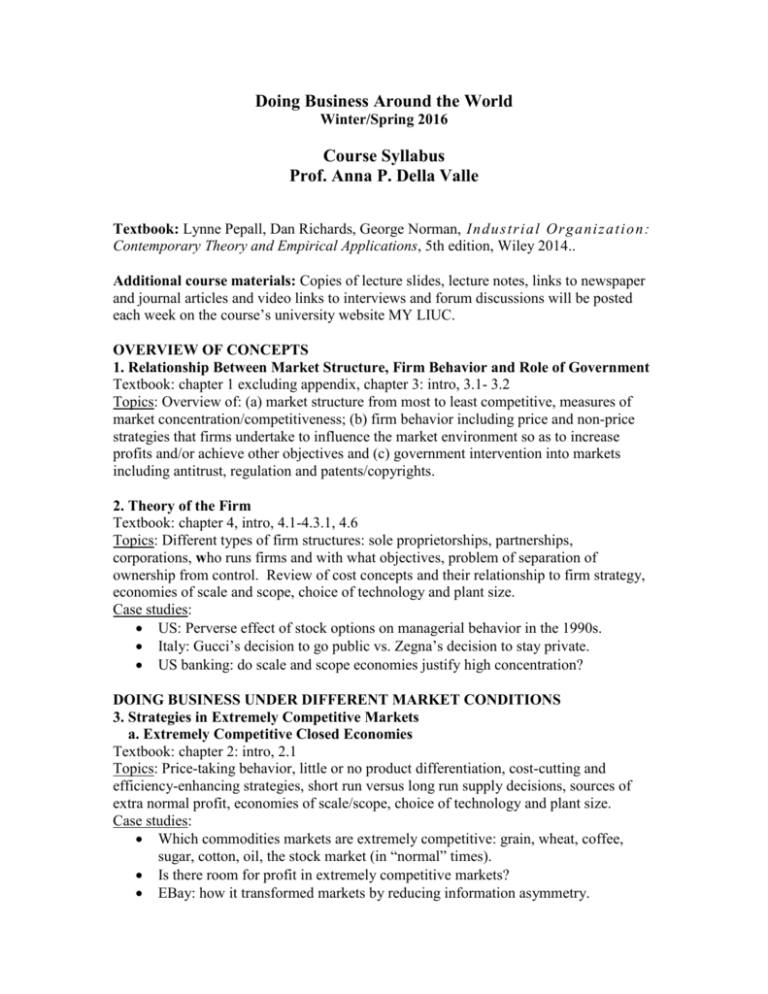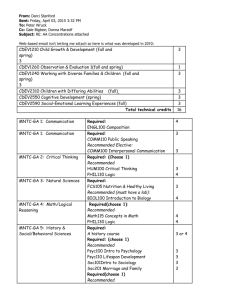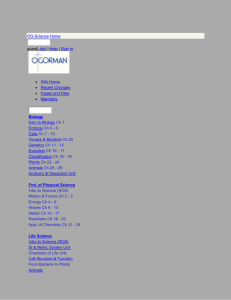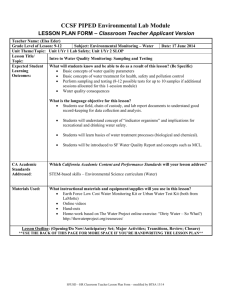Each lecture will be based on a real-world case study
advertisement

Doing Business Around the World Winter/Spring 2016 Course Syllabus Prof. Anna P. Della Valle Textbook: Lynne Pepall, Dan Richards, George Norman, Indust ri al Organi zat i on: Contemporary Theory and Empirical Applications, 5th edition, Wiley 2014.. Additional course materials: Copies of lecture slides, lecture notes, links to newspaper and journal articles and video links to interviews and forum discussions will be posted each week on the course’s university website MY LIUC. OVERVIEW OF CONCEPTS 1. Relationship Between Market Structure, Firm Behavior and Role of Government Textbook: chapter 1 excluding appendix, chapter 3: intro, 3.1- 3.2 Topics: Overview of: (a) market structure from most to least competitive, measures of market concentration/competitiveness; (b) firm behavior including price and non-price strategies that firms undertake to influence the market environment so as to increase profits and/or achieve other objectives and (c) government intervention into markets including antitrust, regulation and patents/copyrights. 2. Theory of the Firm Textbook: chapter 4, intro, 4.1-4.3.1, 4.6 Topics: Different types of firm structures: sole proprietorships, partnerships, corporations, who runs firms and with what objectives, problem of separation of ownership from control. Review of cost concepts and their relationship to firm strategy, economies of scale and scope, choice of technology and plant size. Case studies: US: Perverse effect of stock options on managerial behavior in the 1990s. Italy: Gucci’s decision to go public vs. Zegna’s decision to stay private. US banking: do scale and scope economies justify high concentration? DOING BUSINESS UNDER DIFFERENT MARKET CONDITIONS 3. Strategies in Extremely Competitive Markets a. Extremely Competitive Closed Economies Textbook: chapter 2: intro, 2.1 Topics: Price-taking behavior, little or no product differentiation, cost-cutting and efficiency-enhancing strategies, short run versus long run supply decisions, sources of extra normal profit, economies of scale/scope, choice of technology and plant size. Case studies: Which commodities markets are extremely competitive: grain, wheat, coffee, sugar, cotton, oil, the stock market (in “normal” times). Is there room for profit in extremely competitive markets? EBay: how it transformed markets by reducing information asymmetry. Google, Facebook, Amazon: is the internet driving competition or market monopolization? b. Extremely Competitive Open Economies Topics: Open markets turn countries into importers or exporters, benefits from trade, rationales for restraints on trade, impact of price floors, tariffs, quotas, subsidies and exchange rates on importing and exporting countries’ producers, consumers and governments, effectiveness of WTO sanctions in resolving trade conflicts, contribution of bilateral agreements in international trade liberalization. Case Studies: Drastic price swings in world oil markets US phases out quotas on Chinese textiles Is China’s RMB/US$/Euro exchange rate “fair” competition? Poor countries’ walk out of World Trade Association (WTO) talks WTO retaliatory tariffs: EU vs.US steel and bananas; US vs. Brazil cotton. The ongoing battle between Airbus and Boeing 4. Strategies in Monopolistically Competitive (Niche) Markets Textbook: chapter 19, intro, 19.1-19.3 Topics: The power of successful product differentiation, branding, marketing, advertising, estimating effects on cost and demand, experience vs. search goods, the role of reputation, Lancaster’s characteristic model, the Lerner index, the Dorfman-Steiner condition. Case studies: Top 10 US advertisers: advertising budgets ranging from 10 to 30% of sales. Why do consumers pay premiums of 30-40% for brand name products (even when they have identical ingredients?) Strategy Italy: focus on quality and uniqueness Strategy Germany: focus on technology and reputation The Chinese threat: how can you turn your competitors into clients? 5. Strategies in Non-Cooperative Oligopoly Markets Textbook: chapter 9: intro, 91.-9.3 Topics: Modeling behavior and devising strategies, applying game theory to firm decision-making, first mover/incumbent advantage, dominant strategies, estimating how uncertainty, transactions costs, information, subsidies, change the market outcome. Case studies: Hollywood: what movies to release and when Advertising: whether to adopt a high level advertising budget Boeing/Airbus: whether to develop new large-body aircraft 6. Strategies in Cooperative Oligopoly Markets (Cartels) Textbook: chapter 14, intro, 14.1-14.2.1, 14.3.2 Topics: Significant advantages of cartel-like behavior, factors that facilitate cartel formation, causes of cartel instability and cheating. Case studies: OPEC oil cartel’s strategy: once successful now almost defunct Russia: briefly the wild card in the world oil market Cartel strategies among major producers of pharmaceuticals, beer, flat screens, animal feed and switch gear in the US, EU, China and Japan. Price fixing in the market for vitamins: Roche/BASF/Takeda/Rhone Poulenc. 7. Strategies in Monopoly (and Large Share) Markets Textbook: chapter 2, intro 2.1.2; chapter 20, intro, 201.1-20.2.1, 20.4; chapter 21: intro, 21.6 Topics: Barriers to entry, ownership of key resources, cost advantage, know-how, patents, brand name, entry-deterrent and market retention strategies, economies of scale/scope, mergers and acquisitions, anti-competitive behavior. Case Studies: Newscorp’s media empire Entry-deterring strategies in the airline industry. Google acquisition strategy Hitting the R&D patent jackpot: Prozac and Viagra GOVERNMENT INTERVENTION INTO MARKETS 8. Antitrust Textbook: chapter 8: intro, 8.4.1; chapter 12: intro, 12.4; chapter 13: intro, 13.1, 13.3, 13.5; chapter 15: intro, 15.6 Topics: US and EU antitrust rules and regulations aimed at controlling market power, collusion among competitors, anticompetitive actions by a single firm including predatory pricing, illegal tie-ins, exclusive contracts and territories, denial of access to essential facilities; US Department of Justice merger guidelines. Case Studies: Microsoft, Intel antitrust suits: illegal attempts to monopolize market for PC operating systems and microchip processors IBM antitrust suit: illegal tie-in US denies merger of DirectTV and Echostar satellite US allows merger of AOL/Time Warner and AT&T/Comcast 9. Regulation Topic: Rationales for and types of government intervention into markets. What industries to regulate, why and how, regulation of entry, standards, quality of service, prices, information; regulation in the presence of market failures/negative externalities; regulation of natural monopolies: cost-plus vs. price-cap methods, implications for goldplating and efficiency; unique issues associated with regulation of public airwaves, media and information services and addictive goods (cigarettes and liquor). Case studies: Used car maket: Akerloff’s market for lemons Canada: Anti-smoking cigarette packaging campaign US: media cross-ownership and concentration rules Fuel efficiency: gasoline taxes vs. mileage standards CO2 emissions: tradable emissions permits Italy: Italian highway system: a public/private partnership Should the government intervene to avoid excessive bubbles in the real estate and stock markets? 10. Deregulation and Liberalization Topic: What industries to deregulate/liberalize, why and how, privatization of infrastructure industries, rationales and conditions for deregulation, controversy surrounding excessive liberalization of financial markets. Case studies: UK: Deregulation of electricity generation US: Deregulation of telecommunications, cable television and trucking Greece: government opens “closed” professions Italy: privatizations--from telecom to tomatoes Eastern Europe: privatize, liberalize—too much too soon? Degrees of financial markets liberalization: US, Cina, EU, Canada




